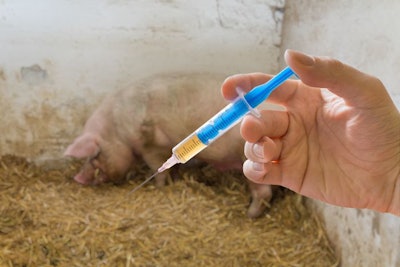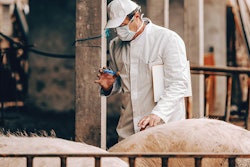
USDA-ARS research scientists Manuel Borca and Douglas Gladue discuss new developments in African swine fever vaccines
PODCAST: Are we closer to a commercial ASF vaccine? (09:41)
Ann Reus: Hello and welcome to the Feed Strategy podcast. I’m your host, Feed Strategy senior reporter Ann Reus.
Manuel Borca and Douglas Gladue are research scientists at the U.S. Department of Agriculture’s Agricultural Research Service, where they work to develop vaccines against African swine fever. They both were honored recently for their work at the agency, and they’ve had some exciting developments in their research.
In April, Manuel Borca was named Distinguished Senior Research Scientist of the Year for 2022, in recognition of his outstanding contributions to veterinary virology and discovery and development of vaccines against ASF. Douglas Gladue received the 2021 Arthur S. Flemming Award for his exceptional achievements in basic science.
And just on the heels of those honors, the ASF vaccine candidate the two have worked on passed an important safety test required for regulatory approval, moving the vaccine one step closer to commercial availability.
Borca and Gladue are back here on the podcast to talk about all of this.
First off, congratulations to both of you on your recent awards. Can you tell me what this recognition means to you? Dr. Borca, why don’t you start.
Manuel Borca: Well, this means that what we have done in the lab has been translated to the real world. And this is something that usually is, first of all, it’s something very rare to happen. It happened to me first time in my career. And it’s this is a really good with thing, right, and something that we had done in the lab can be potentially useful for the real world to solve a real problem.
Reus: Dr. Gladue?
Douglas Gladue: For me, I’m obviously honored to be the recipient of the Arthur S. Flemming Award and honored to be in the company of the current and past recipients of this award. It has been rewarding watching what was once just a concept basically on a piece of paper that we’re talking about, to now, looking at it’s going to make a real impact into the field of African swine fever, and potentially even being a tool to help control the current ASF pandemic.
Reus: Last time we spoke, about a year ago, the big news in ASF vaccines was that the USDA had developed a vaccine candidate that does not rely on live pigs and their cells for vaccine production. Since then, USDA research has shown that one of its vaccine candidates is successful in blocking the spread of ASF. And just recently, a vaccine candidate has passed a critical milestone to get it one step closer to approval. Are these all different vaccine candidates, or is this the journey of one candidate?
Borca: These are two different vaccine candidates, right, but they are related. The vaccine that had passed the safety test lately and we published, this is the what we call I177L vaccine. That is the first version of this vaccine that had been sent to our collaborators in Vietnam. And they’ve performed all this analysis showing that the vaccine is safe in pigs under different protocols that need to be followed in order to show that the vaccine is stable, genetically stable, and does not revert to virulence. The other vaccine that is a modified form of the I177L, that is the vaccine that was in the news last time I believe, is the vaccine that can be grown in a cell line and is basically an adaptation of the I177L vaccine, but that suffered some genetic modifications that allow the virus to grow in a cell line. That vaccine, this adopted vaccine, this adopted version of the 177L had been also transferred to our partners, commercial partners and are right now are under development.
Reus: Dr. Gladue, did you have anything to add?
Gladue: I think the only thing to add would be that it’s important to notice that the original I177L vaccine grown in macrophages was developed over a year before the cell culture adopted. I177L/LVR vaccines. So obviously the first-generation vaccine that’s going to go out is going to be the one that was developed first and that’s the I177L in macrophages but the other cell culture-adopted vaccine is in a commercialization pipeline.
Reus: Is there any other research or development going on with other vaccine candidates that we haven’t talked about?
Gladue: I think it’s important to say that most of our research is to make new scientific discoveries in both ASF vaccines but also in other areas of ASF vaccinology or virology. And sometimes these discoveries can lead to new vaccine candidates; that’s how we ended up first discovering I177L was through our initial virology-type approach. We are also working on the next generation of live attenuated vaccines, which would include DIVA (differentiating infected from vaccinated animals) markers. That’s a marker that can differentiate between vaccinated and infected animals that will be critical in areas that are trying to eradicate ASF. In discovery of some of these different DIVA markers, we can also try to work to define the protective antigens that are needed for an effective vaccine for African swine fever. And this is a critical step in making an effective subunit ASF vaccine. And that will be probably the next generation after all the live attenuated vaccines in our pipeline are commercialized.
Reus: What is the next step with the ASF vaccine candidates you’ve been working on?
Borca: Right now, we have developed like six different vaccine candidates altogether, and they are different. We have patented all of them, we have distributed through licensing, all of them to different commercial companies. The status of the development of each of these vaccines are, in most of the cases we don’t know, what they are doing, except in those cases that we collaborated with them, we don’t know exactly what is the level of development in each of these vaccines in each of these companies that have licensed the vaccines.
So what we’re following more closely is that I177L macrophage vaccine and I177 cell-adapted vaccines. And we are working very hard in trying to get a DIVA marker to be introduced in our candidates. And mainly, and our main effort at this point is towards the identification of conditions that may be involved in the production of immunity, since that will be the basis for the development of subunit vaccines, means vaccines that are not complete virus but are vaccines that are based in the administration of individual proteins. And that will be the next step forward. And, again, we’re working very hard on that. And it will take some time until we get some result. But that’s the next step.
Reus: I know the regulatory approval process is long and slow, but do you feel like there’s been good progress made in the past year in getting us closer to a viable ASF vaccine?
Gladue: I think that the process does feel slow. But we achieved several milestones over the past year, including successful field trials, additional safety testing. One of these tests was the reversion to virulence tests that we just published, which was critical milestone and the first time that reversion of virulence test for any live attenuated vaccine for African swine fever was conducted successfully. Currently, we are waiting for the Department of Animal Health in Vietnam to approve the vaccine. So at this point, I do believe that we’re getting very close to a viable, commercialized ASF vaccine.
Reus: That’s exciting. I know you’ve both said you don’t like to put timelines on things, but are you getting closer to seeing the light at the end of the tunnel on an African swine fever vaccine?
Borca: Well, it probably will be necessary to define what is the light in the tunnel, right. What we think is that we are closest probably to approval by the government of Vietnam with the use of this particular vaccine. And that certainly will open up possibility of having something that is not there right now. And that is a vaccine that will be put in the field. And protect against African swine fever. Do we need improved vaccines? Probably we will need and that is what I mean is that depends on what we define as what the light in the tunnel is. And certainly, as we say, just a minute ago, we need to move forward and we need to go towards the development of the new generations of vaccines, and live attenuated vaccines and also subunit vaccines.
Gladue: I can just add that I think we’re getting very close with the first commercial ASF I177L. So for that candidate, that particular vaccine, I do think, if you’re calling the light at the end of the tunnel commercialization, we’re getting very close and it is visible.
Reus: I’d like to thank Manuel Borca and Douglas Gladue for taking the time to talk with me again, and thanks to the audience for listening. I’m Ann Reus for Feed Strategy.


















